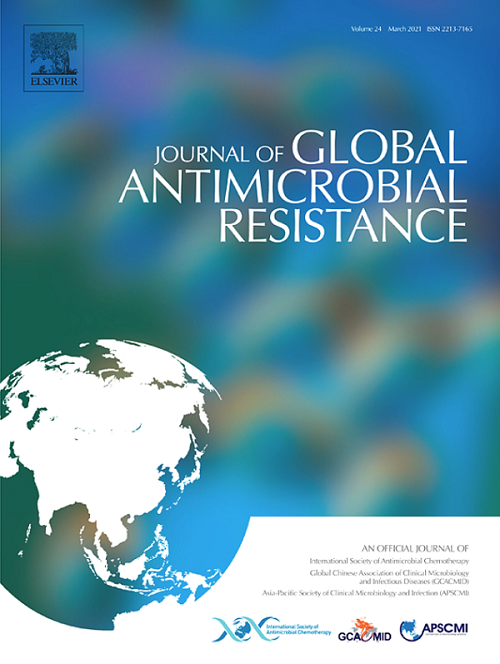Intestinal colonisation of vancomycin-resistant enterococci among patients with cancer at Jimma University Medical Center, Ethiopia: A comparative cross-sectional study
IF 3.7
3区 医学
Q2 INFECTIOUS DISEASES
引用次数: 0
Abstract
Objective
Vancomycin-resistant enterococci (VRE) pose a major threat in hospital settings. Patients with cancer are at a higher risk of hospital-acquired infections such as VRE. This study aimed to determine the intestinal colonisation rate of VRE in patients with cancer at Jimma University Medical Center, southwest Ethiopia.
Methods
A comparative cross-sectional study was conducted prospectively from April to September 2021 at Jimma University Medical Center on 113 patients with cancer. An equal number of apparently healthy individuals were included for comparison. Stool samples were collected from both patients with cancer and apparently healthy individuals, then cultured on bile esculin azide agar. Vancomycin resistance was determined by minimum inhibitory concentration and disk diffusion method, whereas antibiotic susceptibility to other antibiotics was performed by disk diffusion method. Data were entered into Epidata v. 4.6.0.6 and analysed by SPSS v. 26.
Results
The overall colonisation rate of Enterococcus species was 76.9% (87/113) in patients with cancer and 80.5% (91/113) in apparently healthy individuals, with no statistically significant difference. However, the intestinal colonisation rate of VRE was higher in patients with cancer (12.6%; 11/87) compared with apparently healthy individuals (4.4%, 4/91). VRE isolates showed the highest resistance to tetracycline (66.7%) and the lowest resistance to chloramphenicol (13.3%). Multidrug resistance was observed in more than half (66.7%; 10/15) of the VRE isolates.
Conclusions
The intestinal colonisation rate by VRE was higher in patients with cancer compared with healthy individuals. Regular screening for VRE colonisation, along with improved infection-prevention practices, are vital to reduce the risk of VRE infections.
埃塞俄比亚吉马大学医学中心癌症患者中万古霉素耐药肠球菌的肠道定植:一项比较横断面研究
目的探讨万古霉素耐药肠球菌(VRE)对医院的威胁。癌症患者发生VRE等医院获得性感染的风险较高。本研究旨在确定埃塞俄比亚西南部吉马大学医学中心癌症患者的VRE肠道定植率。方法于2021年4月至9月在吉马大学医学中心对113例癌症患者进行前瞻性比较横断面研究。同样数量的健康个体被纳入比较。收集了癌症患者和表面健康个体的粪便样本,然后在叠氮化胆磷脂琼脂上培养。采用最小抑菌浓度法和纸片扩散法测定万古霉素耐药性,采用纸片扩散法测定其他抗生素的药敏。数据输入Epidata v. 4.6.0.6,用SPSS v. 26进行分析。结果肿瘤患者肠球菌总定殖率为76.9%(87/113),表面健康人群为80.5%(91/113),差异无统计学意义。然而,癌症患者的VRE肠道定植率更高(12.6%;11/87),而明显健康个体(4.4%,4/91)。VRE分离株对四环素的耐药性最高(66.7%),对氯霉素的耐药性最低(13.3%)。半数以上(66.7%)存在多药耐药;10/15)的VRE分离株。结论肿瘤患者肠道VRE定殖率高于健康人群。定期筛查VRE定植,同时改进感染预防措施,对于降低VRE感染风险至关重要。
本文章由计算机程序翻译,如有差异,请以英文原文为准。
求助全文
约1分钟内获得全文
求助全文
来源期刊

Journal of global antimicrobial resistance
INFECTIOUS DISEASES-PHARMACOLOGY & PHARMACY
CiteScore
8.70
自引率
2.20%
发文量
285
审稿时长
34 weeks
期刊介绍:
The Journal of Global Antimicrobial Resistance (JGAR) is a quarterly online journal run by an international Editorial Board that focuses on the global spread of antibiotic-resistant microbes.
JGAR is a dedicated journal for all professionals working in research, health care, the environment and animal infection control, aiming to track the resistance threat worldwide and provides a single voice devoted to antimicrobial resistance (AMR).
Featuring peer-reviewed and up to date research articles, reviews, short notes and hot topics JGAR covers the key topics related to antibacterial, antiviral, antifungal and antiparasitic resistance.
 求助内容:
求助内容: 应助结果提醒方式:
应助结果提醒方式:


